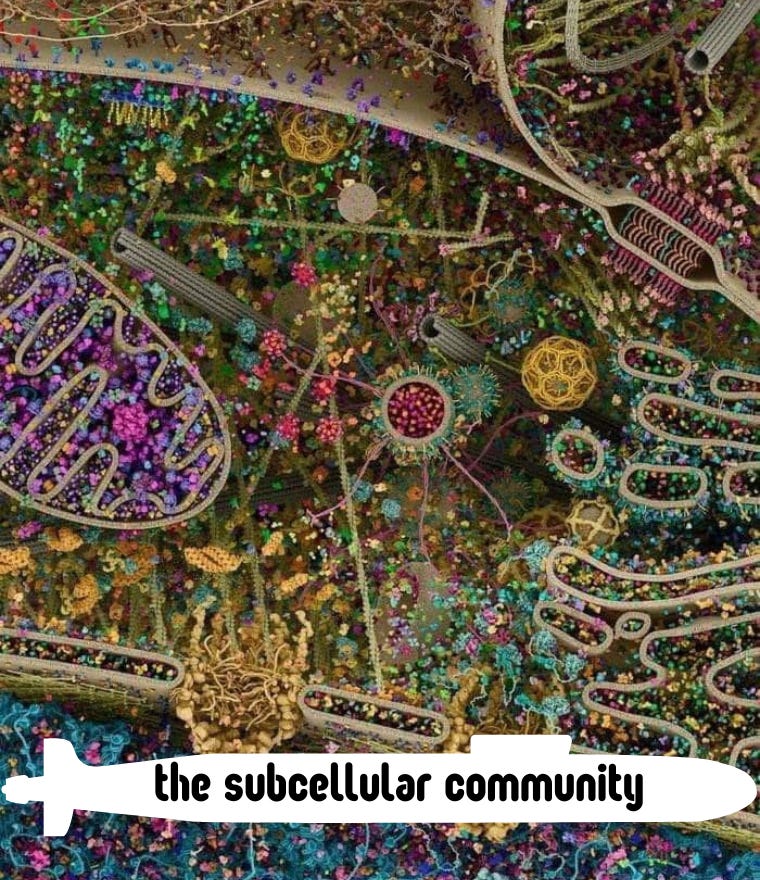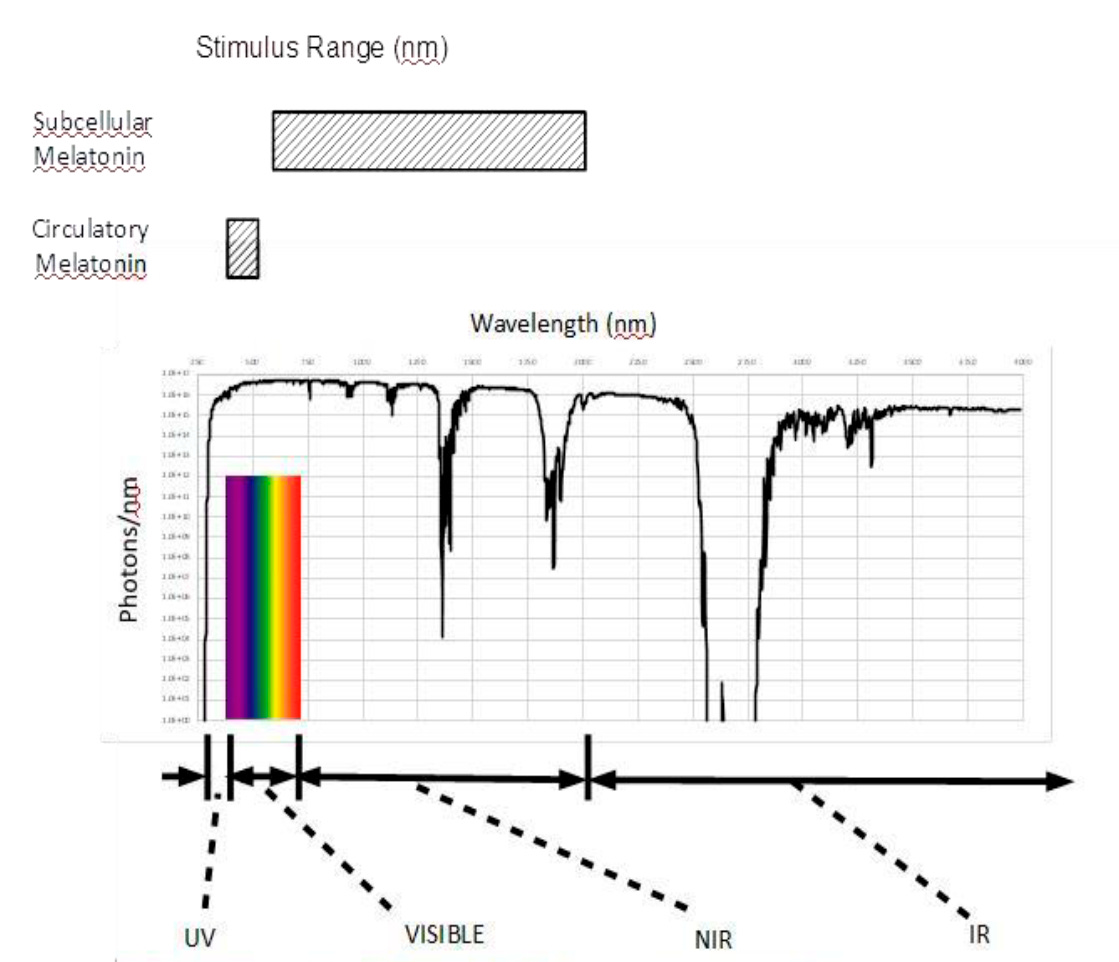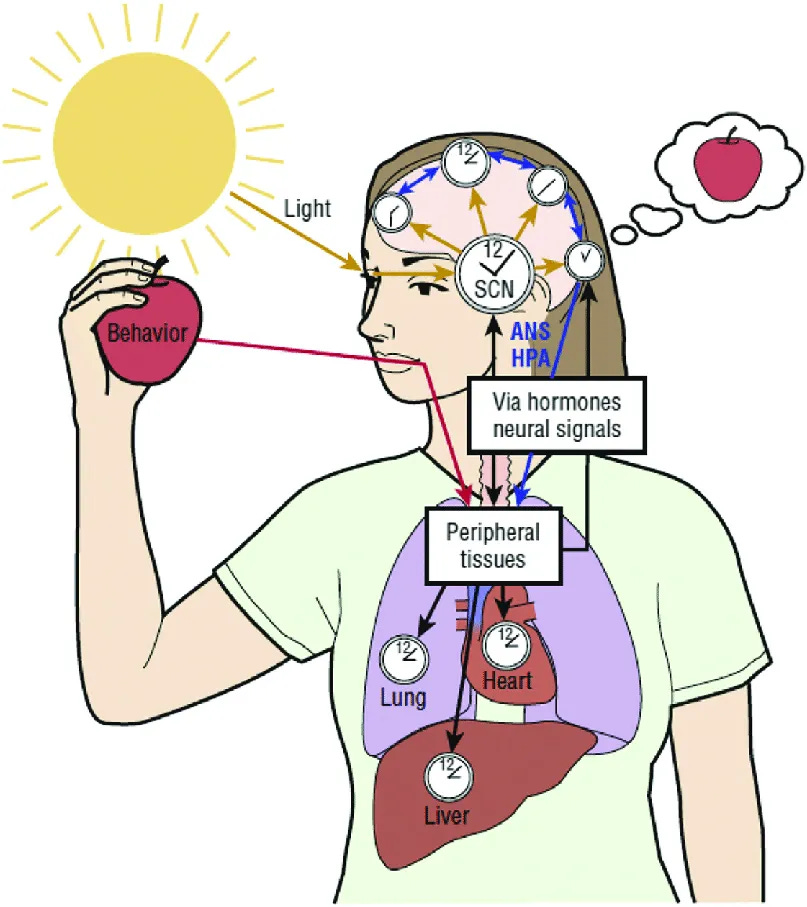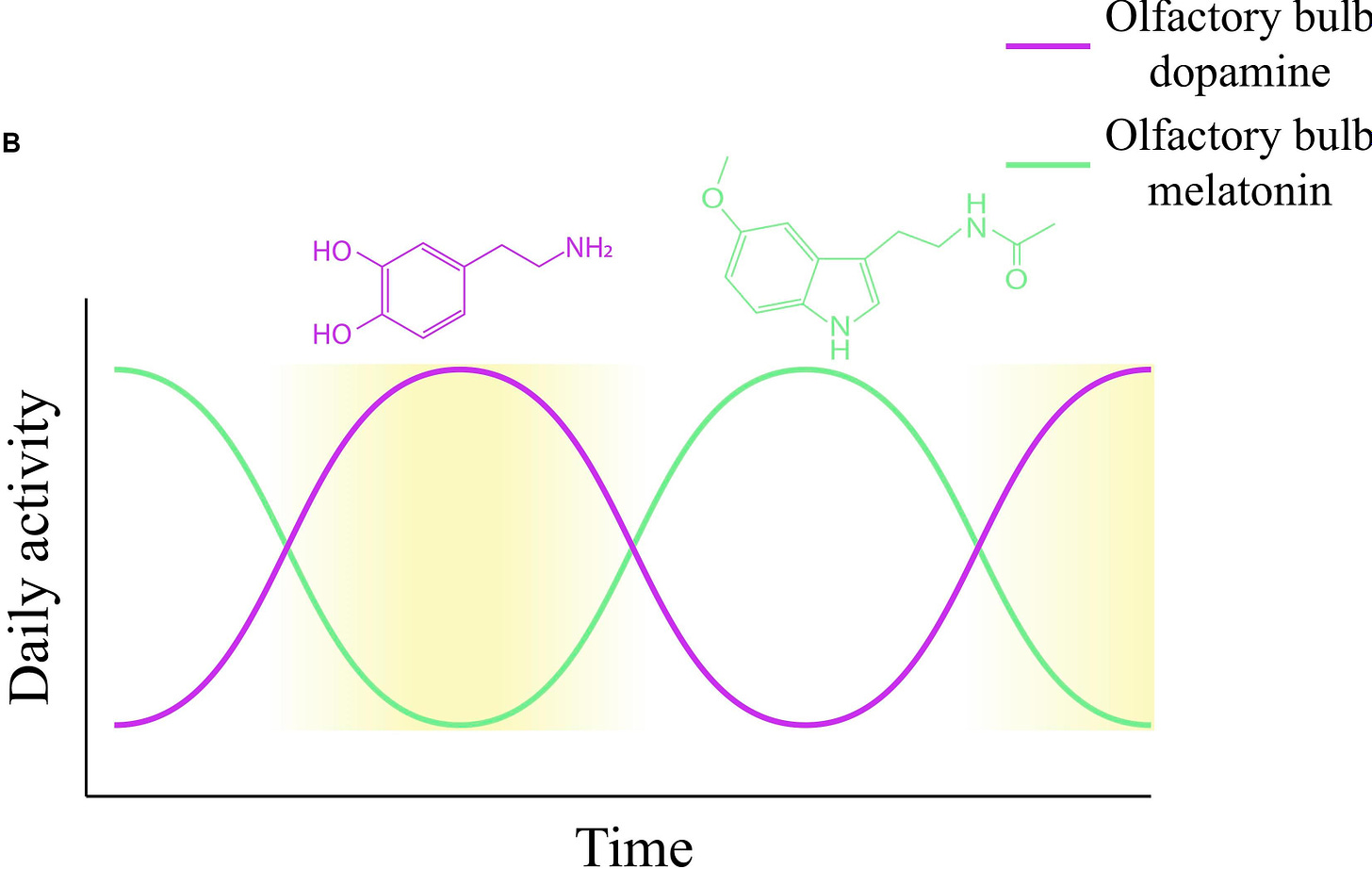How to heal with subcellular melatonin
Why oral supplements may hurt our eyes |How to treat EMF radiation - Part 1
In the coming weeks, I’ll be doing a series on what proactive steps we can take to mitigate EMF damage. This is part 1.
Here’s what you’ll learn in this article:
1. How I like to structure my day to maximize melatonin absorption
2. Two more reasons I love AM sunlight
3. The subcellular difference
4. The Sun we don’t see
5. Building our body’s medicine chest
6. Why pregnant mothers need sunlight
7. Why you may want to ditch the melatonin pills
Did you know that taking melatonin orally can lead to vision loss?1
Many of us know of melatonin as “the dark hormone.”
Did you know that there is a more powerful type of melatonin that our bodies make during the day, apart from the one that is secreted by our pineal gland at night?
This second type, also known as subcellular melatonin, is able to clean up toxic waste from our bodies caused by damage from EMFs, as well as regenerate our bodies, specifically our eyes.
In this article, I’ll explain why you may want to consider being reborn this Spring.
What does my day look like?
I like to “take” my melatonin first thing in the morning.
I make sure to see the sunrise daily, even if it’s cloudy. I’ll go back outside from 9am to 11pm.
Why am I so religious about getting my AM Sun?
I need to get my daily “fix” otherwise my body won’t repair itself.
Seeing the sunrise not only resets our circadian rhythm, which optimizes our metabolism and regulates our hormones, the blue light at sunrise is the most intense giving us a natural boost of adrenaline (cortisol).
After the sunrise, I have another boost of adrenaline AKA my first cup of coffee.
At around 9am, UV light begins to shine. This UV does a couple things - it lowers our cortisol level, but more importantly allows our bodies to make tryptophan.
Tryptophan is absorbed by our bodies at 280nm (UV), and is the precursor to serotonin. Serotonin is what our bodies use to make melatonin:
Two more reasons I like an AM dose of Sunlight:
The UV light from the Sun is gentler in the AM than the UV-B and C wavelengths in the afternoon. As we expose ourselves to gentler UV-A light frequencies, our skin builds a pigment called melanin.
The powerful antioxidant effects of melanin protect us from the more intense forms of UV-B and C. This is why springtime, like morning, is the best time to begin building our skin’s melanin. I’ve been doing it for years, and can now be outside all day. Although I do wear a hat for protection. Yes shorts too.
The highest concentrations of melatonin are actually found in our eyes. Ocular melatonin uses AM light to regenerate our eyes’ melanopsin receptors, rods and cones.
Let’s get Subcellular
Melatonin is produced and has been detected in the mitochondria in many cells and has also been identified in tissues including our: brain, retina, lens, cochlea (ear), skin, GI tract, liver, kidney, thyroid, pancreas, thymus, spleen, immune system cells, and reproductive tract!2
It’s now been shown that our mitochondria (the “little engines of our cells that could”) produce melatonin in many quantities which are orders of magnitude higher than that produced in the pineal gland (circulatory melatonin).

This subcellular melatonin does not necessarily fluctuate with our circadian clock or release into our bloodstream, but instead has been shown to be used up locally within each cell when damage from free radicals occur.
Free radicals are created when we’re exposed to toxins such as those created from wireless radiation or chronic EMF exposure.
The Infrared Light we don’t see
Even in winter, there is always a type of light we can’t see, yet our bodies and organs use in their daily function.
About half of the light emitted by the Sun is in the infrared spectrum, which is the optimal fuel source for our mitochondria and metabolism. There are three types of infrared: near, mid, and far.
Subcellular melatonin can do its job best when we’re exposed to Near Infrared (NIR).
Building our Body’s Medicine Chest
Infrared light stimulates antioxidants, and this cumulative effect creates an antioxidant reservoir that enhances how our body can adapt to rapidly changing stress and conditions throughout the day.
The circulatory melatonin produced by our pineal gland provides supplemental melatonin during periods of low solar activity to damaged or aging cells. 3
Why is NIR light so powerful?
NIR photons, or subatomic particles of light, are scattered several inches into the body even through the skull.
Our bodies love light in the infrared wavelength range.
Infrared, given to us by our Father God and Sun, is the light of rebirth.
Our Crystal Skull
Infrared light has been shown to help wounds heal, repair damage from dementia, macular degeneration, and PTSD.4 5
Our brain appears to be optically designed to distribute NIR photons to the grey matter even down into the folds of the brain.
Our cerebrospinal fluid (CSF), the “oil” of our brains that is washing our our nervous system each night, scatters the NIR light energy where needed, and operates similar to a car lamp.
Think of our CSF as a crystalline fluid that lights up our brain’s museum with infrared laser beams at night so that no “bad guys” steal our treasures:
In this way, our brains are able to uniformly distribute NIR light into the deeper caverns and grey matter that needs it to regenerate.
Why is this important?
When we have a subcellular reservoir of this light in our bodies from the day, we emit this back into the cells that need it, as melatonin drives our battery of healing at night.
Why pregnant mothers need Sunlight
Not only does NIR light penetrate our skull, it also shines right through the placenta and is absorbed by 100% of cells in a fetus, as well as young children.
Amniotic fluid has been shown to have a peak transmission around 850nm (infrared range) similar to the CSF fluid around the brain (as above).
When we expose ourselves to Sunlight, the subcellular melatonin we produce ensures that each healthy cell would be constantly refilling its own antioxidant stores.
Why you may want to ditch the melatonin pills
Melatonin is a hormone, so taking it orally is giving yourself hormone therapy. Many practitioners, such as
and others have had success applying bio-identical hormones. We’re not completely against them, and everyone is unique.However let’s consider our body’s beautiful design, which runs like a solar Swiss timepiece designed by Mother Nature.
Our bodies function according to a circadian (around a day) rhythm, which is governed by a master clock, known as the supraciasmatic nucleus (SCN), located in the hypothalamus of our brain. Our eyes convert the energy (photons) of light into a biochemical signal, which then instructs our SCN, and the rest of our body how and when to rest, repair, and digest. (Hour-mones are chemical messengers that tell our organs what to do, and when to do it.)
When it’s dark, our brain begins to secrete pineal melatonin so that our body can prepare for regeneration and rest at night.
What could happen if we keep intervening in this grand formula, and start overriding the master clock of Mother Nature?
Studies have shown that taking melatonin orally can lead to vision loss. This occurs because as with everything in nature, there are power couples.
Melatonin is coupled to dopamine. When we take melatonin, it lowers our dopamine and vice versa. Why is this important?
Our eyes release their own dopamine, and this hormone is crucial in maintaining the sensitivity and muscle response of our retina.6 In the eye, melatonin plays a crucial role in regulating light sensitivity at night, and also inhibits retinal dopamine. Dopamine supports our vision during the day vision through the cones system of our eyes. A 2009 Study by The Journal of Circadian Rhythms, entitled Impact of oral melatonin on the electroretinogram cone response, found it’s possible that oral melatonin (an inhibitor of retinal dopamine) taken to alleviate circadian disorders may affect how our vision in a negative way.
This is could be why a recent study showed that taking melatonin orally can thin our retina, and make us even more susceptible to blue light from our devices, compounding damage from wireless radiation.
When we embrace the darkness, we may yet see the light.
We are more powerful than you know.
Roman & Bohdanna
This is Part 1 of a series in How to Treat EMF Radiation.
Part 2 - How to repair DNA damage with the food of light: NAD+
Part 3 - How to heal EMF-damaged blood with grounding
Part 4 - How to detox heavy metals & nanotech by building your skin's melanin
Part 5 - How water can insulate us from EMF
If you enjoyed this article and found it valuable, share the knowledge!
Wiechmann, A F, O'Steen, W KMelatonin increases photoreceptor susceptibility to light-induced damage. JF Investigative Ophthalmology & Visual Science
https://iovs.arvojournals.org/article.aspx?articleid=2160933
Tan DX, et al. (2013) Mitochondria and chloroplasts as the original sites of melatonin synthesis: a hypothesis related to melatonin’s primary function and evolution in eukaryotes. J. Pineal Res. 54: 127-138
Zimmerman, S. and Reiter, R.J. 2019. Melatonin and the Optics of the Human Body. Melatonin Research. 2, 1 (Feb. 2019) 138-160.
Dimakatso M et al (2018) Role of photobiomodulation on the activation of the smad pathway via TGF-βin wound healing. J. Photochem. Photobio. B: Bio. 189: 138-144
Hamblin M (2016) Shining light on the head: photobiomodulation for brain disorders. BBA Clinical 6: 113-124.
Witkovsky P. Dopamine and retinal function. Doc Ophthalmol. 2004 Jan;108(1):17-40. doi: 10.1023/b:doop.0000019487.88486.0a. PMID: 15104164.















Thank you for this incredible post. I have forgotten about this refreshing morning sunshine embrace and will start doing it again.
Wondering what 'white spots' in your tan skin mean? Have been a religious user of sunscreen to this day, however the more sun exposure, the more I have been experiencing little white specks on my arms, that do NOT tan...they stay white. These spots do not travel nor grow in size...
Wondering... Does that mean my flesh has hit maximum UV absorption? Inquiring here, since one usually forgets to mention at annual checkup with Family doctor in October (when it is usually rainy and not sunny) LOL